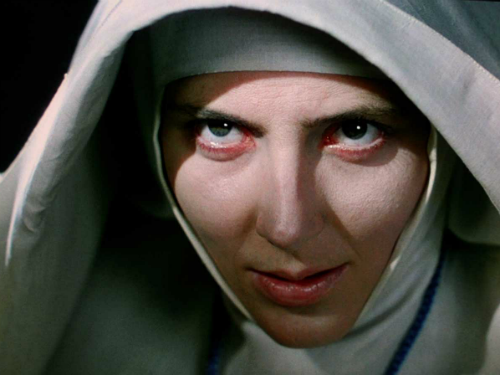
A group of Anglican nuns travel to a remote location in the Himalayas (the Palace of Mopu, near Darjeeling in the Bengal Presidency of British India) to set up a school and hospital for the local people. However they find themselves increasingly seduced by the sensuality of their surroundings in a converted seraglio high up in the mountains and by the local British agent, Mr Dean (David Farrar). Clodagh (Deborah Kerr), the Sister Superior, is attempting to forget a failed romance at home in Ireland.
“I think you can see too far.”
Sister Philippa
“The film is not realistic, it is surrealistic. The starting point was a huge plasterwork set for the palace, built to allow Cardiff complete control over the lighting. Then there were model shots, glass shots and matte shots - all the fantastic tricks of a fantastic trade and executed by ‘Papa’ Day, a scruffy, bearded wizard. The only exteriors, for the lush Himalayan vegetation, were taken on a set built at Leonardslee gardens in Sussex. Visually, Black Narcissus is completely composed; not for a moment are we allowed to escape this deliberate world of saturated Technicolor pigments, spectacular precipices and precarious buildings.
[...]
The budget had continued to grow, and action was needed. Cap in hand they paid a visit to Rank. Marius Goring, who witnessed a [...] meeting, remembers the technique: ‘It was the combination of these two, the peace-maker / diplomat Pressburger and this incalculable, fiery creature Powell, that made it an irresistible pair. I was once present at a meeting with Arthur Rank – they wanted some more money . . . the whole case for The Archers was put by Emeric Pressburger and he was so reasonable about it. He explained everything so simply and sweetly – how everything was going so well, that there was nothing they had to ask for really at all, just a report of how things were going. And Rank and everybody was beaming. Then suddenly Micky Powell who, up until then, had been looking up at the ceiling, suddenly said, “Of course, we must also have some more money... ” Without batting an eye Emeric picked it up and said, “Oh yes, I did forget there is that other matter but it is so unimportant that I... ” and so on and so on. Emeric put them all in such a marvellous mood by the preparation he had done that Micky’s comment passed unnoticed and they got exactly what they wanted... They were incomparable, those two, in working out that sort of plan.'”
Kevin Macdonald1
“Of course, the visual richness of the Powell and Pressburger films has been often and justifiably noted, but I don’t think that enough has been said about their emotional and psychological rigor. Contained within their storybook worlds is a fascination with human drives and impulses. ‘The film is truer and tougher than many of the exotic romantic poems that have an honored place in anthologies of English literature,’ wrote Raymond Durgnat, who saw past the hypnotic surfaces of Black Narcissus to its dramatic spine of steel. If this were merely a well-made movie about a group of nuns brought face-to-face with their repressed sexual urges, it would indeed be nothing more than a ‘dramatic exploitation of celibacy as an opportunity for titillation in the best of taste,’ as James Agee put it in his dismissive contemporary review. It is always tempting to uncouple the unearthly visual beauty and formal control of a Powell and Pressburger film from its psychological exactitude – and that urge is built into the films themselves. The characters (and the audience) are always on the brink of being overwhelmed by beauty, the beauty of the world on the one hand and of art on the other, which holds the impossible but ever present promise of a permanently heightened state. At the same time, however, the action is always firmly anchored in the fallacies and disturbances and longings of being human.”
Kent Jones2
“Watching a Powell-Pressburger film is always an experience in intensity, not to be confused with an intense experience. The Archers create a distinct and sensory-laden world in their movies, a separate cinematic reality, where sights, sounds, and emotions are all heightened. An ‘intense experience’ implies an outside force washing over the viewer, while an ‘experience in intensity’ grants the viewer entrance into a realm outside him/herself. This is not a quarrel over semantics, but an alternative method of mapping a cinematic terra incognita. To judge the super-saturated colors, magical lighting, mythical storylines, and compelling score employed by the Archers as ‘too much’ or ‘an assault to the senses’ is to refuse learning a new language, or exploring a new country. Appealing to the senses alone does not create a world with a doorway, however. The image and sound must have meaning; the story feeds off of the sensory details, merging with myth past, present - and yes sometimes even the future - to finally emerge as its own vision. The 1947 Powell-Pressburger vision Black Narcissus is one such country - within its borders live many sights and sounds, many gradations of emotion, and consequently many stories.”
Mary Bowen3
- 1Kevin Macdonald, Emeric Pressburger. The Life and Death of a Screenwriter (New York: Faber and Faber,1994), 166.
- 2Kent Jones, “Black Narcissus: Empire of the Senses,” Criterion, 20 July 2010.
- 3Mary Bowen, “Blue Nun/Red Desire: The Palette of Piety, Passion, and Monstrosity in Black Narcissus,” The Powell & Pressburger Pages, 2004.

